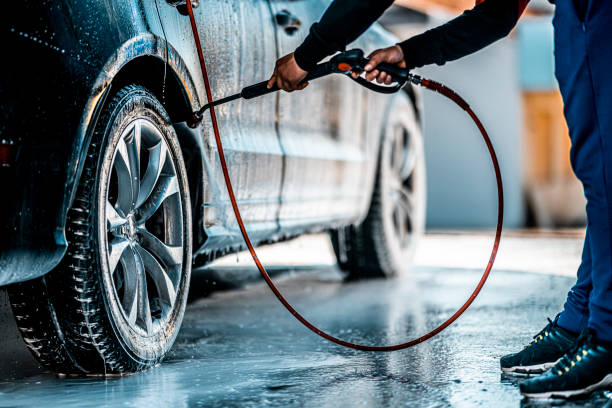All car wash tips and tricks for better car cleaning. Regular cleaning makes the car look nicer. However, it increases the life of the paint. Tree sap, bird droppings, and insect residue can leave dull spots if left on the vehicle for too long.
Regular cleaning also protects against the formation of rust, since rust tends to form where dirt binds moisture to the body like a sponge. On the other hand, the water can run off quickly on clean and well-kept paintwork. In the following, various options are presented to get your own vehicle thoroughly clean again, depending on your budget.
Car wash with the car wash
You can easily wash your car with a car wash in the car wash. These are available at almost every gas station. Usually, such a washing process lasts only a few minutes and your own physical effort is limited to retracting the radio antenna unless it works automatically or your car even has a real antenna.

- You should also critically check again whether all windows are raised as far as they will go and whether the sunroof – if available – has been closed. Otherwise, simply follow the instructions that the automatic car wash gives you.
- Important: Do not drive into the car wash until you are prompted to do so by a signal!
- Incidentally, a convertible with a fabric top should not be sent through the car wash, even if some manufacturers do not object.
Disadvantages of the car wash
As effortless as the car wash option is, it also has a number of disadvantages:
- Firstly, it costs money, and usually quite a bit. You will usually have to shell out 5 to 10 euros for a wash, sometimes even more for premium washes.
- Secondly, car washes are never as thorough as washing by hand. The car is tolerably clean afterward, but the brushes cannot get into many nooks and crannies.
- Thirdly: car washes are not exactly gentle on the paint over the long term. There are better and worse systems here, but after years of visiting the car wash, sensitive paintwork in particular usually looks as if someone had scrubbed it with a scouring pad. Fourth: Even if it sounds banal, the interior of the car is still not clean afterward.
Wash car with hand wash
This is both the gentlest and most cost-effective way to wash your car. Plus, you don’t even have to leave your property, provided you don’t live in a community where washing cars on private property is prohibited. This is sometimes the case for reasons of water protection. In any case, washing vehicles in public places and streets is not permitted. If you do not have your own property or are not allowed to wash your vehicle there, you can visit a washing box at a gas station that is intended for hand washing.
Step by step instructions for washing the car
First of all, stubborn dirt needs to be removed from the vehicle. The best way to do this is to use a garden hose; gas stations also have a high-pressure cleaner for this purpose. With high-pressure cleaners, however, pay attention to the distance, otherwise, the car paint will be damaged. The tires in particular quickly resent the hard jet of water when washing the car. It is best to keep a distance of about one meter and walk over the vehicle with stroking movements. The vehicle should then be washed off with a clean cloth, starting from the roof.
- Bumpers, rims, and side skirts come last. Washcloths, as used in the kitchen, are ideal.
- Also, keep a clean bucket of water handy and rinse the rag in it periodically. Incidentally, the washing-up liquid is not suitable for washing the car, as it dries out the paintwork.
- It’s better to get a car wash at the hardware store. Although these cost a few euros, one bottle of concentrate is easily enough for one to two dozen washes.
- Don’t press too hard on the paintwork, just enough pressure to remove the dirt.
- Don’t forget to clean the car windows. You should also end up opening the doors and the trunk and wiping away the dirt that has accumulated here.
- Once the vehicle has been cleaned, use the garden hose to remove the foam from the vehicle. If you don’t have a hose at hand, simply fill the bucket again with clear water and run it over the car again.
- Then wring out the cloth well and dab excess water off the paintwork to prevent limescale stains.
Wax protects the paint

Once the car has been thoroughly cleaned, you can wax it straight away. The wax layer preserves the paintwork and slows down its aging. In addition, water and dirt roll off more easily, making it much easier for you to do the next wash. You should therefore give your car a coat of wax once or twice a year. Polishing wax is available from hardware stores and car accessory shops.
It is best to apply the wax sparingly with a clean cotton cloth. An old shirt works great here. Incidentally, the wax only belongs on the paint and should not be applied to unpainted plastic parts. On these, the wax dries to a stubborn gray veil.
It is best to proceed in stages. Wax the roof first, then wait a few minutes. Then polish the dried wax with a soft cotton cloth or polishing floss until the paint shines. Then repeat this procedure for the hood, fenders, doors, and so on, one at a time. However, the paint must be meticulously clean and dry. Otherwise, grains of sand will cause scratches, and drops of water will cause streaks in the wax layer.
